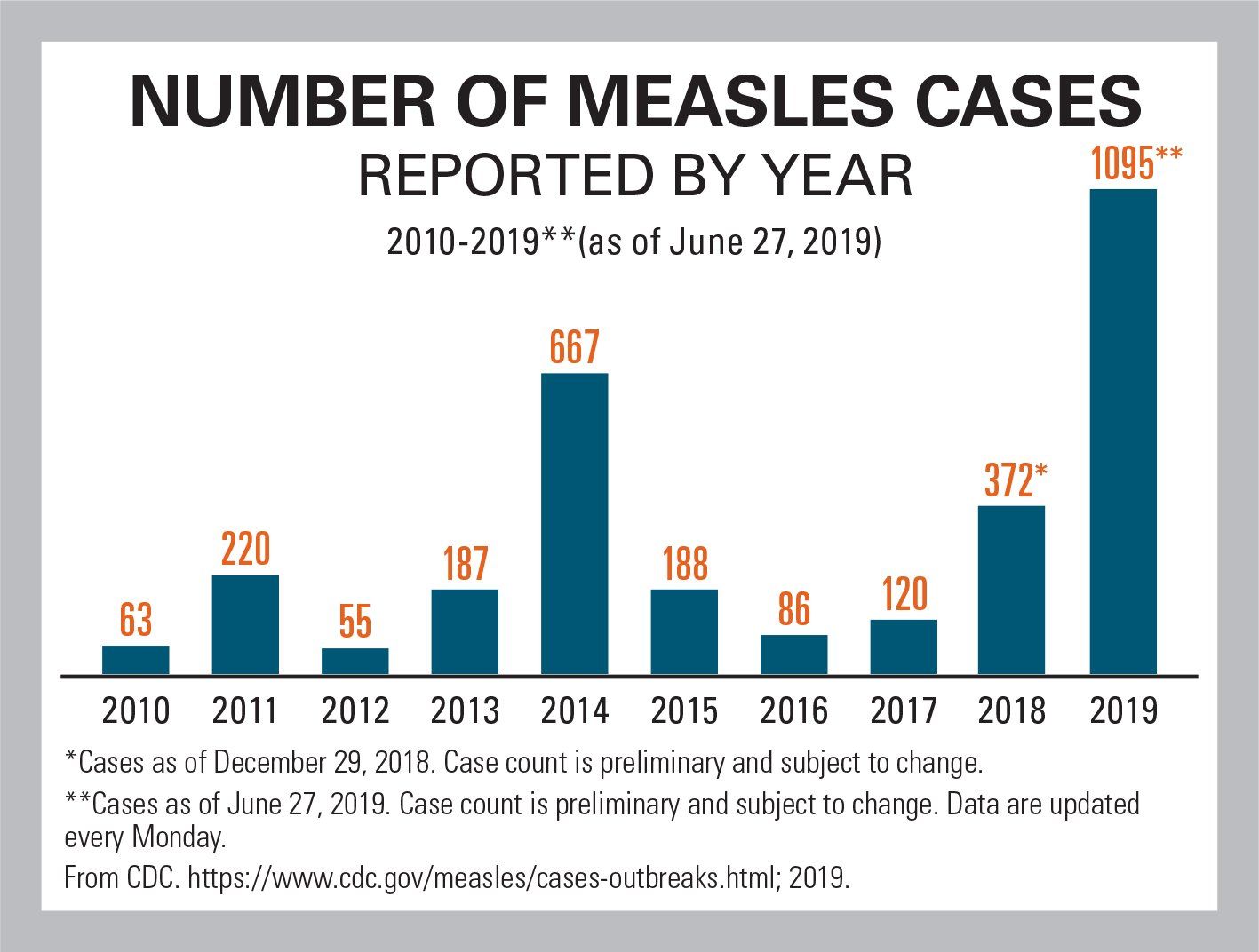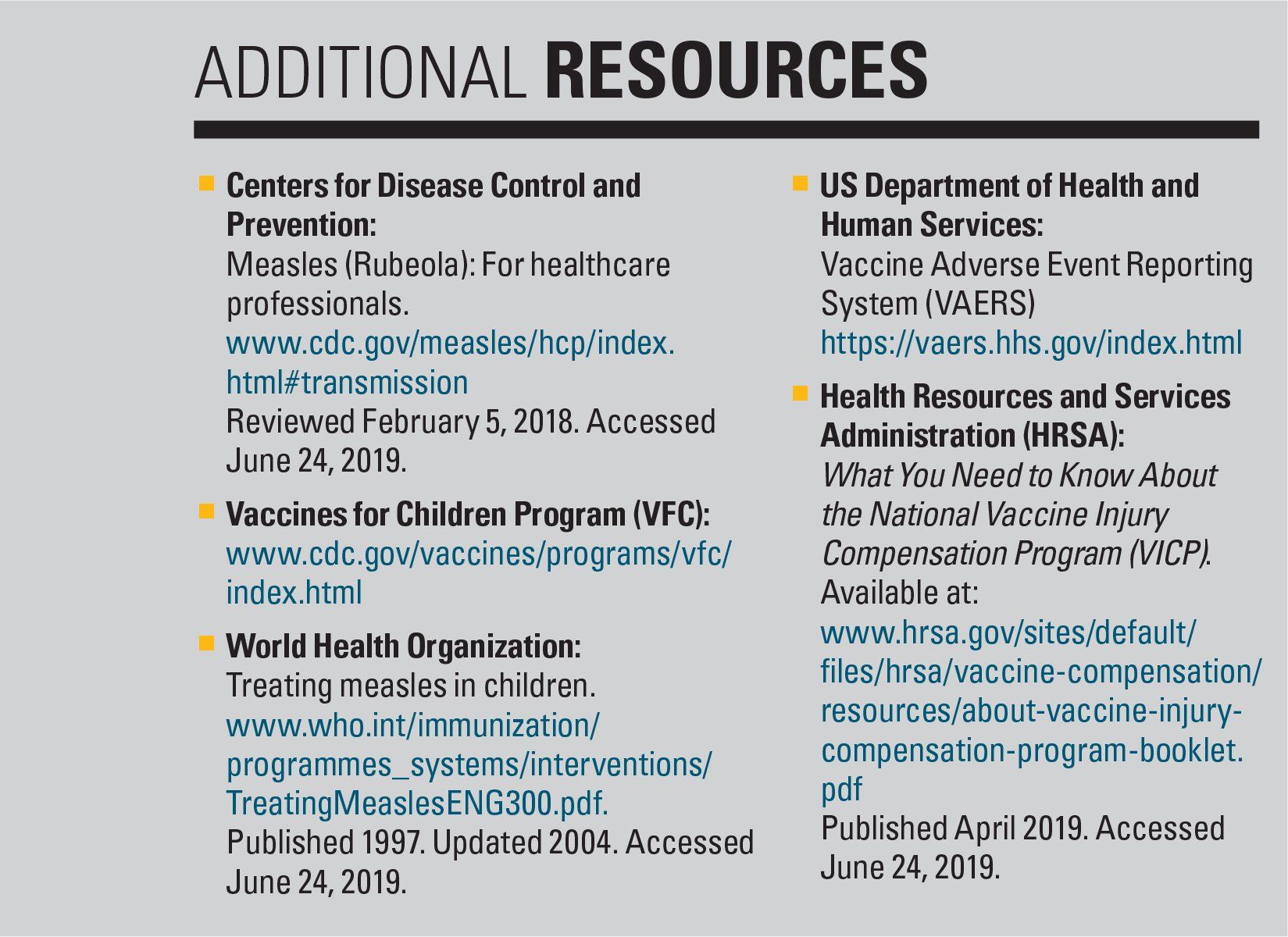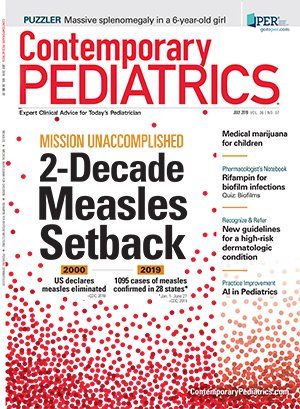Measles makes a comeback: What to know, what to do
Measles is once again a significant public health problem in the United States. Many pediatricians and most parents have never seen actual measles in a child, hence the urgent need to reeducate clinicians and caregivers about clinical manifestations and prevention of the disease.
Measles cases in 2019

Number of measles cases reported by year

Additional resources

In 2000, the United States achieved a monumental public health goal-elimination of sustained transmission of measles for more than 12 months. Unfortunately, this achievement was relatively short-lived, and the United States has been experiencing significant measles outbreaks in the last several years. It is essential for the pediatrician to understand the measles virus including the clinical manifestations, diagnosis, complications, management, and postexposure prophylaxis (PEP) so that by identifying the disease in its earliest stage its spread among the vulnerable pediatric population can be contained.
Epidemiology
Measles is a highly contagious disease with 90% of susceptible individuals developing measles following exposure.1 Transmission may occur person-to-person or via respiratory droplets/small particle aerosols. Respiratory droplets may remain airborne for up to 2 hours, increasing the risk of transmission in public and crowded places.2 Transmission via fomites is possible but less common.3 Underimmunization is the primary source of immunity gaps, and the unvaccinated or unknown vaccination status represents 85% of infected individuals.4
Clinical manifestations
Classic measles proceeds through 4 clinical stages from incubation to recovery:
INCUBATION-The incubation period for measles varies from 7 to 21 days (median, 13 days) after the virus enters via the respiratory tract or conjunctiva.5 Infected individuals are generally asymptomatic during the incubation period. Infected children are contagious from 5 days before the appearance of the rash until 5 days after.
PRODROME-The prodromal phase lasts 2 to 4 days and is characterized by coryza, cough, and conjunctivitis (the “3 C’s”); fever; anorexia; and malaise.7 Photophobia, lacrimation, periorbital edema, and myalgia can sometimes be present. The fever pattern is variable. Prodromal symptoms often worsen several days before the exanthem appears.3
In the 48 hours before the appearance of the exanthem, Koplik spots may appear. These 1-mm to 3-mm, whitish-blue/gray papules on an erythematous base appear on the buccal mucosa opposite the molars. Koplik spots may coalesce and will begin to fade as the exanthem appears. They are pathognomonic for measles and can prompt the pediatrician to begin appropriate management and control measures.8,9 However, not all patients will present with Koplik spots.6,10
EXANTHEM-The exanthem of measles, referred to as morbilliform, is a macular-papular, erythematous, blanching rash. Beginning on the face around the hairline, sides of the neck, and ears, it spreads downward to the trunk and extremities becoming more confluent. The palms and soles are generally spared. In children, the extent of the rash and degree of confluence generally correlate with the severity of the illness. In more severe cases, the rash may be petechial or hemorrhagic.11 High fevers are often seen 2 to 3 days following the appearance of the rash and are associated with lymphadenopathy and respiratory symptoms. Patients usually begin to improve 48 hours after onset of the rash.
The rash lasts from 5 to 7 days and will fade in the same pattern as it appeared. Desquamation may be seen in areas that were more severely affected.
RECOVERY-If fevers persist beyond day 4 following rash onset, the pediatrician should consider a possible measles-associated complication. Cough may persist for several weeks. Immunity following infection is generally considered lifelong.
Complications
Complications of measles are common and occur in 10% to 40% of effected individuals. Complications are more common in the very young, very old, women who are pregnant, or in any patient with an immunocompromised state.6,12
Pneumonia, due to measles itself (the so-called Hecht giant-cell pneumonia) or a secondary bacterial infection, is the most common complication. Otitis media, croup, laryngotracheobronchitis, and diarrhea are also common. Pregnant women are at risk for spontaneous abortion, in utero fetal death, and low-birth-weight infants.12,13
Keratoconjunctivitis may lead to blindness when there is a concomitant vitamin A deficiency.
Although not common, central nervous system complications carry significant morbidity. Complications include encephalitis, acute disseminated encephalomyelitis (ADEM), measles inclusion body encephalitis (MIBE), and subacute sclerosing panencephalitis (SSPE).
ENCEPHALITIS
One of every 1000 measles cases develops acute encephalitis.12 Symptoms generally begin 5 days after the rash onset and can include:
· Fever
· Altered mental status
· Headache
· Vomiting
· Stiff neck
· Meningeal irritation
· Seizures
Workup will reveal a cerebrospinal fluid (CSF) with lymphocytic pleocytosis, elevated protein, and a normal glucose level. One in 4 children will develop neurologic sequela and the encephalitis is fatal in 15% of cases.14
ACUTE DISSEMINATED ENCEPHALOMYELITIS (ADEM)
A demyelinating complication that also occurs in 1 of every 1000 measles cases,12 ADEM is a postinfectious autoimmune response that occurs within 2 weeks of the exanthem.15 Symptoms are similar to that of encephalitis but may also include ataxia, myoclonus, and choreoathetosis. Patients with ADEM also may have signs of myelitis (back pain, para/quadriplegia, sensory loss, and loss of bowel/ bladder control). The CSF will demonstrate lymphocytic pleocytosis and an elevated protein concentration.
Additionally, ADEM is associated with a 10% mortality rate and neurologic comorbidities are common, including epilepsy and behavior disorders.15
MEASLES INCLUSION BODY ENCEPHALITIS (MIBE)
This complication of measles primarily occurs in patients with an impaired cellular immunity within several months of the primary infection. With MIBE, patients will present with seizures, mental status changes, and myoclonus. Some patients may have a concomitant giant cell pneumonia.
SUBACUTE SCLEROSING PANENCEPHALITIS (SSPE)
This progressive degenerative central nervous system disease presents 5 to 10 years following measles infection and is fatal, occurring in 1 in 10,000 measles infections.16 It is most common in children who develop measles before age 2 years. Prior to 1975, the rate of SSPE was 8.5 cases per million cases of measles and declined to 0.06 cases per million with vaccination.17 In the late 1980s and early 1990s as measles cases surged, the incidence of SSPE was thought to be 200 to 400 cases per million.18 In California, SSPE has appeared at much higher rates in unvaccinated children: 730 per million in infected children aged younger than 5 years, and 1640 per million in infected children aged younger than 1 year.19
Diagnosis
In areas where measles is not common, diagnosis can be difficult. The pediatrician should consider measles in any pediatric patient with the following findings:
· One of the 3 C’s: coryza, cough, and conjunctivitis.
· Fever ≥101°F (38.3°C).
· Erythematous maculopapular rash spreading cephalocaudally from the face downward.
· Koplik spots (when present are pathognomonic).
If the pediatrician is considering the diagnosis of measles, patients should be placed in respiratory isolation within healthcare facilities. Suspicion is particularly important in patients with:
· Unknown or questionable immunity to measles.
· Travel to endemic measles areas.
· Potential exposure in a measles outbreak.
Laboratory confirmation of suspected measles cases is essential in febrile pediatric patients with other measles symptoms or other risk factors.12,20 There is a positive serologic test for measles-specific immunoglobulin M (IgM) antibody or detection of measles virus RNA by reverse transcriptase-polymerase chain reaction (RT-PCR) from blood, throat, nasal, nasopharyngeal, or urine samples.
The Centers for Disease Control and Prevention (CDC) recommends obtaining 3 samples when possible:12
· Serum sample for measles IgM.
· Throat or nasopharyngeal swab for viral culture.
· Urine sample for viral culture.
Diagnosis with RT-PCR is most likely in the 3 days following rash onset.1,12,20 The IgM may not be detectable on the day of rash appearance and will be present for approximately 3 days.20
Additional diagnostic options include a 4-fold or greater rise between acute and convalescent sera of measles-specific IgG titers or isolation of measles virus from cultures from specific sites such as blood mononuclear cells, urine, conjunctival swabs, or nasopharyngeal secretions. The IgG titers may not be detectable until 7 days after rash onset and will peak at approximately 14 days. Additionally, there are some false-positive results attributed to cross-reactivity due to IgM caused by parvovirus B19.20
The pediatrician should report any suspected case of measles to his/her local health department within 24 hours.
Management
In general, treatment for measles is symptomatic and includes:
· Control of fever with antipyretics.
· Prevention and control of dehydration.
· Infection-control measures.
· Treatment of bacterial infections such as pneumonia or otitis media.
· Treatment of other complications such as seizures or respiratory problems.
Vitamin A supplementation reduces complications of measles, decreases measles deaths, and prevents delayed recovery because of vitamin A deficiency. It is recommended that vitamin A be administered immediately at diagnosis and again the following day.13 Additionally, a third dose should be administered to any child with clinical evidence of vitamin A deficiency (xerophthalmia, xerosis, Bitot spots) 4 to 6 weeks later.21-23
Vitamin A dosing is age dependent:13
· Infants aged 6 months: 50,000 international units (IU)/day.
· Infants aged 6 to 11 months: 100,000 IU/day.
· Children aged 12 months and older: 200,000 IU/day.
Although data are limited, in vitro studies demonstrate possible efficacy of ribavirin against the measles virus. As a result of measles-associated mortality that can approach 35% in some high-risk groups, some experts recommend its use. High-risk patients include those aged younger than 1 year diagnosed with pneumonia and children aged older than 1 year with pneumonia requiring mechanical ventilation. Small series of case reports have demonstrated beneficial effects.24,25 One randomized trial of ribavirin along with supportive management compared with only supportive management demonstrated decreased duration and severity of fever as well as decreased complications.26
Postexposure prophylaxis
Children exposed to measles who cannot demonstrate immunity should receive postexposure prophylaxis (PEP) or be excluded from certain settings (schools, hospitals, childcare facilities).12
Providing PEP may protect patients from or modify the clinical course of the disease. The 2 options include administration of either: 1) measles/mumps/rubella (MMR) vaccine within 72 hours of initial measles exposure; or 2) immunoglobulin (IG) within 6 days of exposure.12
High-risk patients (infants aged younger than 12 months, pregnant women without evidence of measles immunity, and people with severely compromised immune systems), should receive IG. Intramuscular IG (IMIG) should be given to all infants aged younger than 12 months, but MMR vaccine may be substituted if given within 72 hours of initial measles exposure for children aged 6 to 11 months.12
The pediatrician cannot administer both the MMR vaccine and IG as this will invalidate the vaccine. If not able to administer MMR vaccine within 72 hours as PEP, the vaccine should still be offered to offer protection from future exposures.12
Conclusions
Measles is a significant public health problem. Pediatricians need to vaccinate patients in their offices, promote vaccination in their communities, and, especially, be able to identify and manage measles cases in their practice.
References:
1. MacFadden DR, Gold WL. Measles. CMAJ. 2014;186(6):450.
2. Bloch AB, Orenstein WA, Ewing WM, et al. Measles outbreak in a pediatric practice: airborne transmission in an office setting. Pediatrics. 1985;75(4):676-683.
3. Moss WJ. Measles. Lancet. 2017;390(10111): 2490-2502.
4. Centers for Disease Control and Prevention (CDC). Measles-United States, 2011. MMWR Morb Mortal Wkly Rep. 2012;61:253-257.
5. Piccirilli G, Lazzarotto T, Chiereghin A, Serra L, Gabrielli L, Lanari M. Spotlight on measles in Italy: why outbreaks of a vaccine-preventable infection continue in the 21st century. Expert Rev Anti Infect Ther. 2015;13(3):355-362.
6. Bester JC. Measles and measles vaccination: a review. JAMA Pediatr. 2016;170(12):1209-1215.
7. Campos-Outcalt D. Measles: why it’s still a threat. J Fam Pract. 2017;66(7):446-449.
8. Zenner D, Nacul L. Predictive power of Koplik’s spots for the diagnosis of measles. J Infect Dev Ctries. 2012;6(3):271-275.
9. Perry RT, Halsey NA. The clinical significance of measles: a review. J Infect Dis. 2004;189 suppl 1:S4-S16.
10. Bentley J, Rouse J, Pinfield J. Measles: pathology, management and public health issues. Nurs Stand. 2014;28(38):51-58.
11. Abramson O, Dagan R, Tal A, Sofer S. Severe complications of measles requiring intensive care in infants and young children. Arch Pediatr Adolesc Med. 1995;149(11):1237-1240.
12. Centers for Disease Control and Prevention (CDC). Measles (Rubeola). Prevent measles with MMR vaccine. Available at: https://www.cdc.gov/measles/. Reviewed May 13, 2019. Accessed June 19, 2019.
13. Kondamudi NP, Waymack JR. Measles. StatPearls [Internet]. Treasure Island, FL: StatPearls Publishing LLC; 2019. Available at: https://www.ncbi.nlm.nih.gov/books/NBK448068/. Accessed June 19, 2019.
14. Cherry JD. Measles virus. In: Feigin RD, Cherry JD, Demmler-Harrison GJ, Kaplan SL. Feigin and Cherry’s Textbook of Pediatric Infectious Diseases. 6th ed. Philadelphia, PA: Saunders Elsevier; 2009:2427.
15. Johnson RT, Griffin DE, Hirsch RL, et al. Measles encephalomyelitis--clinical and immunologic studies. N Engl J Med. 1984;310(3):137-141.
16. Paules CI, Marston HD, Fauci AS. Measles in 2019-going backward. N Engl J Med. 2019;380(23):2185-2187.
17. Centers for Disease Control and Prevention (CDC). Subacute sclerosing panencephalitis surveillance-United States. MMWR Morb Mortal Wkly Rep. 1982;31(43):585-588.
18. Bellini WJ, Rota JS, Lowe LE, et al. Subacute sclerosing panencephalitis: more cases of this fatal disease are prevented by measles immunization than was previously recognized. J Infect Dis. 2005;192(10):1686-1693.
19. Wendorf KA, Winter K, Zipprich J, et al. Subacute sclerosing panencephalitis: the devastating measles complication that might be more common than previously estimated. Clin Infect Dis. 2017;65(2):226-232.
20. Bellini WJ, Helfand RF. The challenges and strategies for laboratory diagnosis of measles in an international setting. J Infect Dis. 2003;187 suppl 1:S283-S290.
21. Hussey GD, Klein M. A randomized, controlled trial of vitamin A in children with severe measles. N Engl J Med. 1990;323(3):160-164.
22. Huiming Y, Chaomin W, Meng M. Vitamin A for treating measles in children. Cochrane Database Syst Rev. 2005;(4):CD001479.
23. Imdad A, Mayo-Wilson E, Herzer K, Bhutta ZA. Vitamin A supplementation for pre-venting morbidity and mortality in children from six months to five years of age. Cochrane Database Syst Rev. 2017;3:CD008524.
24. Ortac Ersoy E, Tanriover MD, Ocal S, Ozisik L, Inkaya C, Topeli A. Severe measles pneumonia in adults with respiratory failure: role of ribavirin and high-dose vitamin A. Clin Respir J. 2016;10(5):673-675.
25. Bichon A, Aubry C, Benarous L, et al. Case report: ribavirin and vitamin A in a severe case of measles. Medicine (Baltimore). 2017;96(50):e9154.
26. Pal G. Effects of ribavirin on measles. J Indian Med Assoc. 2011;109(9):666-667.
